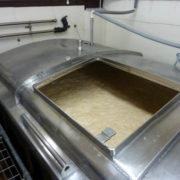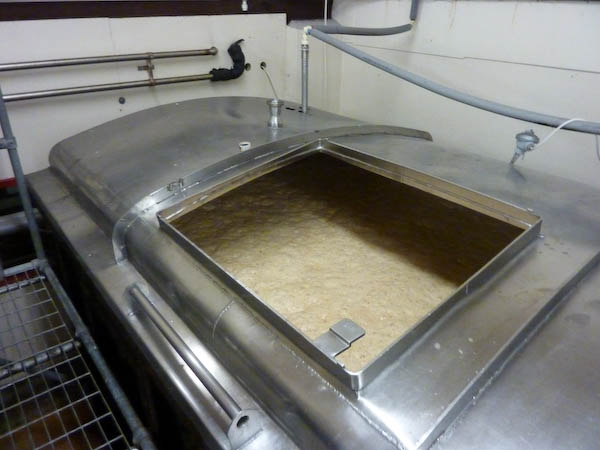Open Fermentation Without the Contamination
I’ve read a lot of people making a big deal about open fermentation, especially home brewers thinking anything other than a carboy fitted with a bung and an airlock will lead to infected beer and spoiled brews. Open fermentation makes many people think of the sour beers brewed in Belgium or in quaint 19th century farmhouse settings.
On the opposite side of the coin though, if you walk into any number of breweries here in the UK, Belgium, Germany and even some in the US, all fermentation will be carried out in open vessels. I know this from personal experience because this is how all the beer I brew at work is fermented. So what’s with all the controversy with open fermentation?
Table of Contents
So You Don’t Have To Keep Fermentation Airtight?
As a home brewer I have gone through stages of open fermentation and closed fermentation using demijohns and airlocks not once have I had an infection in one of my batches. Nor have I ever been that worried about it.
The first 4-5 batches of beer I made (probably 9 or 10 years ago now) I used a book published in the 1970’s that suggested you ferment in a bucket and skim the yeast off every day it didn’t actually say you can store the yeast for later brews. So this is what I did for all of my first batches of beer. It was only when I got more involved with home brewing and read further that I switched to closed fermentation believing that an infected beer was inevitable.
Since those early years though and many more years of practice and research I’ve learned that some of the best beers in the world are openly fermented and it’s not just because the breweries that brew them have any special conditions under which they ferment them.
Fermentation Under Sterile Conditions
Most breweries that I’ve visited here in the UK have fermentation rooms but there are no special environments just air filters to remove impurities and dust from the air, pretty much every FV I’ve seen on a brewery tour has been open although a lot of craft breweries now use closed tanks to aid kegging and carbonating the beer. I know many breweries around the world use open fermenters too and mostly under conditions the same as you would have at home.
Once the krausen has built up on top of the beer and CO2 is being produced no further protection from the air is needed
The Home Brew Scale Open Fermentation
Pretty much all of my fermentations now consist of racking the cooled beer into a fermenting bin (plastic bucket), pitching an adequate amount of yeast and setting the lid loosely on top to stop dust from getting in. No airlock or completely closed and airtight fermenters.
As long as you have aerated the wort properly and created a healthy amount of yeast to pitch then fermentation starts between 2 – 6 hours. The krausen builds up and the carbon dioxide sits over the top of the beer stopping any oxygen from contacting it.
It is only after the initial burst of fermentation (say a few days to a week) has completed I then move the beer to a closed container with an airlock fitted and allow it to condition. This process is very much like a lot of commercial breweries in the UK who use condition tanks to store the beer in before casking or bottling.
Leaving the fermentation open after until the krausen has sunk back into the beer allows you to do whatever you need to such as adding fruit, dry hopping or harvesting yeast and secondary fermentation can then be completed under closed conditions when less CO2 is being emitted to form a blanket over the beer.
What’s The Benefit Of Open Fermentation?
- I believe open fermentation leads to more yeast character. There is less pressure on the yeast in an open fermenter and as beer ferments, the undesirable compounds that are produced can easily disperse which is less likely in a closed fermentation. If it leads to better beer, you will have to deciede for yourself.
- Convenience, there is less equipment to sanitise especially if you have to use more than one carboy for a batch and an open fermenter with a wide neck is far easier to clean than one with a narrow neck
- Adding fruit and hopping during fermentation is far easier both in terms of access and cleaning
- As long as your fermenter is big enough you don’t have to worry about airlocks clogging or fitting blow off tubes. I’ve had numerous clogged airlocks but never had an open fermenter overflow.
- Probably the best reason is to harvest yeast for reusing. It’s simply a case of skimming it off the top with sanitised equipment and storing. You’ll notice the earlier stages of fermentation will bring dark trub material to the surface which can be discarded but after this you have a plentiful supply of clean, fresh, healthy yeast and is one of the best ways to collect it, rather than from the bottom of the fermenter after primary fermentation.





This is the absolute best website/blog on home brewing beer and wine, bar none. I used to make cheap cider and wine kits when I was younger and didnt really know what I was doing, this site is really encouraging and I’m getting back into the hobby, starting with 1 gallon all grain IPA and the blueberry wine recipe.
Really excellent stuff, thanks!
Thanks for the kind words, I hope the new brews taste great.
Cheers and happy brewing!
Great article! I think we all worry about contamination and this is a really enlightening viewpoint.
Thanks, Kolka, agreed.
Hey thanks! After looking at many different sites this has been by far the best and helpful! Really appreciate it ✌
Thank you for the kind words. Glad the site helped!
Thanks for the great article. I am now doing an experiment with a German Hefeweizen. I split the batch into two stainless steel conical fermenters. One is my standard closed fermentation. In the other, I left the lid completely off and only have a cheese cloth covering (to keep any bugs out). I’ll be interested to see if there are any differences. Thanks again for the inspiration!
I’m fermenting with a cheese cloth cover now. How long did you wait before racking? Thx
Should I allow the crown to completely sink into the wort before racking into a secondary sealed environment, or maybe rack when it begins to fall; maintaining the CO2 seal to avoid contamination? Thx
You don’t have to wait till it completely falls. I have had occasions when the krausen has not fallen at all. You should wait until most of the activity has subsided, the beer will continue to off gas for a while once the main activity has decreased